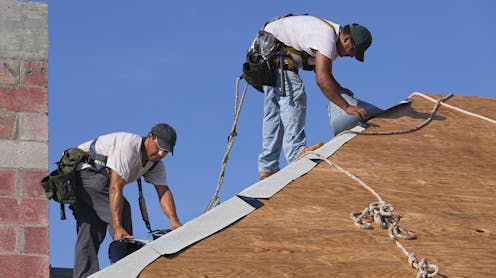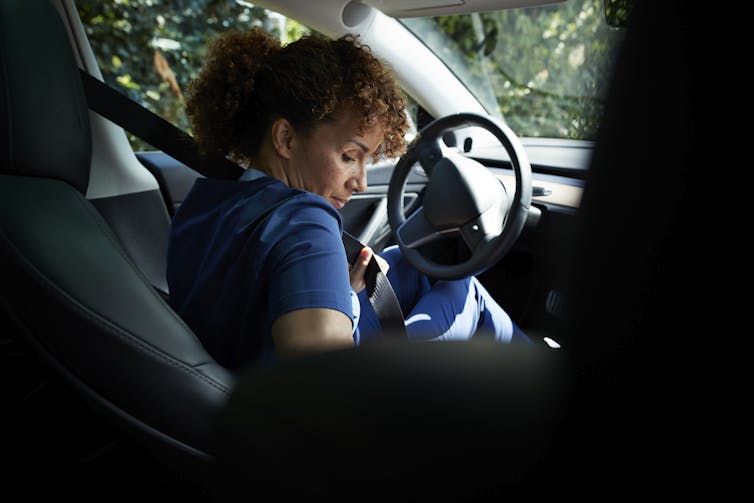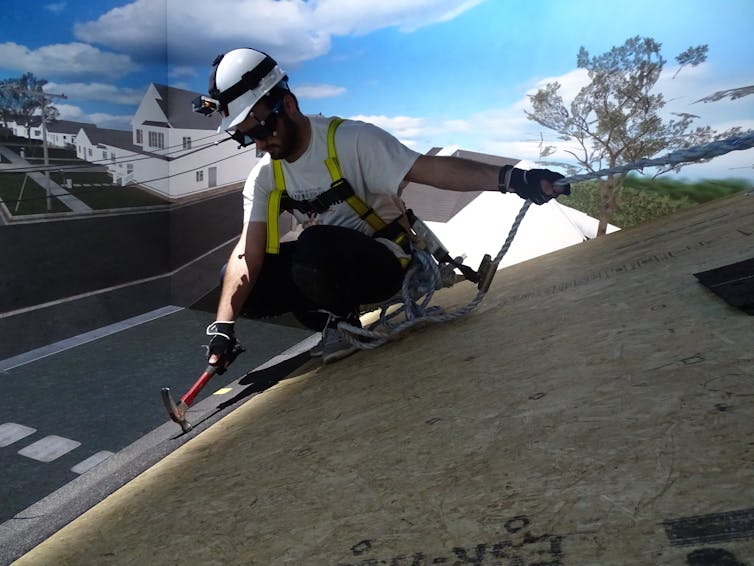The safer you feel, the less safely you might behave – but research suggests ways to counteract this
If you feel safer, you might take more risks – canceling out the benefits of various safety interventions. But educating people about this paradox and allowing for some personal choice might help.

Interventions designed to keep people safe can have hidden side effects. With an increased perception of safety, some people are more likely to take risks.
For example, some vehicle drivers take more risks when they are buckled up in a shoulder-and-lap belt. Some construction workers step closer to the edge of the roof because they are hooked to a fall-protection rope. Some parents of young children take less care with medicine bottles that are “childproof” and thus difficult to open.
Techniques designed to reduce harm can promote a false sense of security and increase risky behavior and unintentional injuries.
As civil engineers and applied behavioral scientists, we are interested in ways to improve workplace safety. Our ongoing research suggests that employers need to do more than provide injury-protection devices and mandate safety rules and procedures to follow. Job-site mottos like “safety is our priority” are not enough. Employers need to consider the crucial human dynamic that can counteract their desired injury-prevention effects – and tap into strategies that might get around this safety paradox.

Why precautions can trigger more risks
A well-established psychological phenomenon known as risk compensation or risk homeostasis explains this safety paradox. An intervention designed to prevent or reduce unintentional injury decreases one’s perception of risk. Then that perception increases the person’s risk-taking behavior, especially when taking a risk has a benefit, such as comfort, convenience or getting a job done faster.
Just as thermostats have a set point and activate when the temperature deviates from normal, people maintain a target level of risk by adjusting their behavior. They balance potential risks and perceived benefits.
For instance, a driver may compensate for safety interventions like a vehicle shoulder-and-lap belt, an energy-absorbing steering column and an airbag by driving faster – trading off personal safety for time saved. The heightened odds of a crash at higher driving speeds don’t affect only the driver; they also put other vehicles, pedestrians and cyclists at more risk. An individual’s risk compensation can influence the injury-prevention impact of protective devices and safety-related rules and regulations for the population overall.
In our own research, we investigated the risk compensation phenomenon among construction workers using an immersive mixed-virtual reality scenario that simulated a roofing task. We asked participants to install asphalt shingles on a real 27-degree sloped roof within a virtual environment that conveyed the sense of being 20 feet off the ground. Then we monitored the workers’ actions and physiological responses while they completed roofing tasks under three levels of safety protection.

As expected, more safety interventions created a false sense of invulnerability in participants. Adding guardrails to the roof’s edge and providing a fall-arrest system for the roofer provided real protection and rightfully increased a sense of security, which resulted in participants’ stepping closer to the edge of the virtual roof, leaning over the edge, and spending more time exposing themselves to the risk of falling. Participants increased their risk-taking behavior by as much as 55%. This study provided empirical evidence that safety devices can implicitly encourage workers to take more risks.
One hypothesis that flows from our research is that educating people about the risk compensation effect could reduce their vulnerability to this phenomenon. Future studies are needed to test this possibility.
A perception of choice matters
A crucial consideration is whether people feel the decision to take precautions is their own.
In studies one of us conducted with a colleague, pizza-delivery drivers demonstrated safer driving overall when they chose to increase particular safe-driving behaviors. For instance, drivers at one store participated in setting a goal to stop completely at intersections at least 80% of the time, while at another store management assigned drivers the 80% complete stopping goal. Drivers from both groups met that goal. But among the drivers who self-selected the target, there was a spillover effect: They increased their use of turn signals and lap-and-shoulder belts.

A study early in the COVID-19 pandemic identified a similar spillover or response generalization effect. People who wore a face mask outdoors where mask wearing was not mandated also maintained a greater interpersonal distance from others than did people without masks.
In this case, as with the delivery drivers, one safe behavior spilled over to another safe behavior – the opposite of risk compensation – when people had the perception of personal choice. We believe perceived choice was the critical human dynamic that influenced people to generalize their safety behavior rather than compensate for the reduction in risk.
Top-down rules and regulations can stifle a perception of choice and actually motivate people to intentionally do things that flout a safety mandate in order to assert their individual freedom or personal choice. People tend to bridle against the feeling of having a freedom taken away and will do what they can to regain it.
“Click It or Ticket” and other management attempts to dictate safety come with disadvantages that might negate any safety gains. Letting people feel they have a say in the matter can decrease the amount of risk compensation they experience and increase a safety spillover effect.
Jesus M. de la Garza is a subject matter expert for ARTBA’s Safety Certification for Transportation Project Professionals (SCTPP) program.
E. Scott Geller is an Alumni Distinguished Professor at Virginia Tech; a Senior Partner with Safety Performance Solutions, Inc., President of Make-A-Difference, LLC; and Co-Founder of GellerAC4P,Inc.
Sogand Hasanzadeh received funding from National Science Foundation (Award Number 2049711 and 2049842) and the Electri International (NECA).
Read These Next
As DOJ begins to release Epstein files, his many victims deserve more attention than the powerful me
Powerful men connected to Jeffrey Epstein are named, dissected and speculated about. The survivors,…
How to reduce gift-giving stress with your kids – a child psychologist’s tips for making magic and a
Depending on family circumstances and a child’s personality type, gift giving runs the gamut of fun…
People are getting their news from AI – and it’s altering their views
Even when information is factually accurate, how it’s presented can introduce subtle biases. As large…






